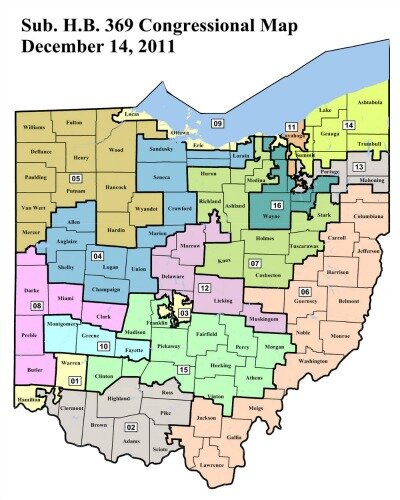Making every vote count: Ohio seeks a fairer way to map congressional districts
In 2021, the state will implement a new system to help curb the worst excesses of gerrymandering.
One person, one vote.
That’s our civics class understanding of how government representation works in America.
But when it comes to electing our representatives in Congress, not all votes are created equal. In fact, according to political and legal experts, millions of people’s votes are “wasted” in congressional elections throughout the country, thanks to a system of drawing congressional district lines that stretches back to the very beginnings of our nation. Called “gerrymandering,” it gives the dominant political party in the legislature of each state the right to draw congressional district lines to their own advantage. The name harkens back to 1812 when Massachusetts Governor Elbridge Gerry drew a contorted district that a newspaper likened to a “monstrous salamander.”
In recent years, gerrymandering has faced legal challenges leading all the way up to the U.S. Supreme Court, which ruled in June that it wasn’t a matter for the nation’s top court to settle. As a result, it’s now up to each state and its citizens to decide whether they will keep the old system of drawing district lines or replace it with a new one.
Ohio, too, has been part of the redistricting battleground and, in 2021, will put in place a new system of drawing congressional maps overwhelmingly approved by voters in a 2018 referendum. (See sidebar for details). Legal and political experts say it will help curb the worst excesses of gerrymandering but is unlikely to resolve the problem of giving every vote equal weight. Other states that don’t have citizen-initiated referendums will have an even harder time wresting the redistricting process from the control of the dominant political party.
Why is gerrymandering, which has been perfectly legal in America for more than 200 years, seen now in such a negative light? With today’s mapmaking software and computerized analysis of voter rolls, gerrymandering is more effective than ever in creating and maintaining one party’s domination over congressional seats. Congressional districts in many states, including Ohio, now look more like jigsaw puzzles with bizarrely drawn lines dividing many cities and counties. As a result, the odds have increased dramatically that an opposing party may get the majority of votes in a state but still get fewer than half of the state’s congressional seats.
“I think that a reasonable person can agree that isn’t how it should work,” says David Niven, a professor of political science at the University of Cincinnati who teaches a class on election laws.
But in its recent 5–4 decision on gerrymandering cases from Republican-controlled North Carolina and Democrat-controlled Maryland, the Supreme Court ruled that there were “no manageable” criteria for creating fair district lines and that it was a political decision best left to the states themselves.
“It was a decision not to decide, which, of course, is another way of letting the rascals get away with it,” Niven says.
Daniel Tokaji, an authority on election law at Ohio State University’s Moritz College of Law, agrees that the Supreme Court’s reasoning “was demonstrably flawed in that there were several lower courts who had found and applied manageable standards for redistricting.” A popular and simple way of measuring the impact of gerrymandered lines is called an “efficiency gap” — a formula that counts and weighs the wasted votes in both parties that have no impact on which candidate wins or loses, says Aaron Montgomery, an associate professor of mathematics at Baldwin-Wallace University in Berea.

“You can’t tell (the efficiency gap) just by looking at the district. A funny shape doesn’t necessarily indicate a problem,” he says.
On the other hand, conservative groups like the Heritage Foundation say the Supreme Court made the right decision.
“Engaging in politics does not violate the Constitution,” Hans von Spakovsky, a legal expert at the Heritage Foundation, wrote in a recent column for the National Review.
He argues that our Founding Fathers recognized that drawing congressional maps was inherently political and, therefore, gave that responsibility to elected representatives. “The solution to gerrymandered districts should come from state legislatures, not the courts.”
Yet most political experts agree that gerrymandering is more than just an issue of representative fairness. Citizens who see their votes wasted in districts drawn to give one party an advantage lose their interest in voting and disengage from the political process.
“It doesn’t matter who the candidates are. It doesn’t matter what the issues are. It doesn’t matter what the mood of the country is. These districts were drawn to be unlosable,” Niven says.
Worse, candidates who know they don’t have to please the voters of the opposing political party are more likely to pander to extremists in their own party, making bipartisan compromise nearly impossible and creating gridlock on important issues like gun control and health care reform.
“Bipartisanship (in Congress) is like the dodo,” Niven says. “It’s not something we see walking around much anymore.”
By law, states with more than one congressional district must redraw their boundaries every 10 years, following the U.S. Census, to account for any shifts in population. Typically operating in secret, party strategists gain the advantage by “packing” as many of the opposing party’s voters into as few districts as possible. Or they can “crack” those opposing votes by spreading them over multiple districts where their own party can still win the majority of votes.
In 2011, working in secret from a hotel room they dubbed “the bunker,” the Republicans in Ohio squeezed as many Democrats as possible into four districts for the 2012 congressional election. As a result, with just 51 percent of the vote, Republicans were able to win comfortably in the other 12 districts, giving them a three-to-one advantage in congressional seats. In Hamilton County, for instance, the largely Democratic vote was “cracked” and neutralized by merging the county’s western portion with Republican-dominated Warren County (District 1) and the county’s eastern portion with Republican counties stretching all the way east to Portsmouth (District 2).
Critics say the most glaring example of gerrymandering in Ohio is the 9th Congressional District, where Democratic voters were packed into a single district to force two Democratic incumbents — U.S. Rep. Marcy Kaptur of Toledo and U.S. Rep. Dennis Kucinich of Cleveland — to vie against each other. The district has been dubbed “the Snake on the Lake” because it “eats its way across the southern border of Lake Erie” while fragmenting Cleveland and Toledo, according to a 2018 lawsuit filed against Ohio for gerrymandering. The lawsuit was challenged by Republicans all the way to the Supreme Court but won’t be considered now that the nation’s highest court has decided that redistricting is an issue best dealt with at the state level.
Even so, the Supreme Court has set limits on gerrymandering over the last 50 years or so. Drawing districts along racial lines was declared unconstitutional in a series of decisions in the early 1960s leading up to passage of the Voting Rights Act of 1965. In 1964, in Wesberry v. Sanders, the court ruled that states must regularly adjust their congressional districts so that each of the 435 members in the House of Representatives represents roughly the same number of people. The court’s aim was to give voters in growing urban areas equal weight with those in rural areas. And in 1993, the court again barred gerrymandering along racial lines in Shaw v. Reno, this time ruling against districts drawn to favor racial minorities.
Beginning in 2021, Ohio will launch its new redistricting process under the guidelines set down in Issue 1, the referendum approved by 75% of Ohio voters in 2018. The majority party in the state legislature will no longer have complete control of drawing the congressional map. Instead, a three-stage and publicly open process will encourage a bipartisan approach to redrawing the lines.
If all three of those stages fail, the control falls back to the majority party but the district lines can be set for only four years rather than 10 and will be subject to stricter guidelines on dividing cities and counties. Gerrymandering opponents would continue to have the option of suing in state court to overturn maps that they perceive as unfair.
Catherine Turcer, executive director of Common Cause Ohio and a long-time advocate of gerrymandering reform, is encouraged that the new process will include public hearings and input from citizens along the way.
“We can help set a culture where good mapmaking happens,” she says. “There are now lots of ways to mitigate the worst aspects of gerrymandering.”
But Niven is somewhat less hopeful. The new process “does create the incentive to seek out the support of the other party (in drawing district lines), but what we don’t know is whether that will be incentive enough. Or will the old (partisan) habits be too hard to give up?”
If all else fails, opponents of gerrymandering in Ohio can still sue in state court, Turcer notes. But as Niven points out, that, too, could end up being politically tainted since judges in Ohio are elected.
“The irony is that we would be challenging election laws before elected officials,” he says.
Support for Ohio Civics Essential is provided by a strategic grant from the Ohio State Bar Foundation to improve civics knowledge of Ohio adults.
The views expressed herein do not necessarily represent those of the Ohio State Bar Foundation.




















